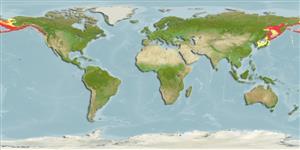Common names from other countries
分类 / Names
俗名 | 同种异名 | Catalog of Fishes(属, 种) | ITIS | CoL | WoRMS | Cloffa
Teleostei >
Gadiformes (Cods) >
Gadidae (Cods and haddocks)
Etymology: Gadus: Latin, gadus = a fish, cod? (Ref. 45335); chalcogrammus: Name from the Greek 'chalcos' meaning brass and 'gramma' meaning mark (Ref. 6885).
More on author: Pallas.
Issue
This species is placed in the genus Gadus in Eschmeyer (CofF ver. Jan. 2012: Ref. 89336). More studies are needed for a complete revision of all genera of Gadidae.
Environment: milieu / climate zone / depth range / distribution range
生态学
海洋; 半咸淡水 底中水层性; 非迁移的; 深度上下限 ? - 1280 m (Ref. 50550), usually 30 - 400 m (Ref. 54255). 極; 68°N - 34°N, 129°E - 120°W (Ref. 54255)
North Pacific: from Kivalina, Alaska, to the southern Sea of Japan and to Carmel, California, USA. The occurrence off the northern part of Baja California (Mexico), as reported from Quast and Hall, (1972) (Ref. 6876) is apparently erroneous.
北太平洋: Kivalina, 阿拉斯加到日本海南部與對卡梅爾,美國加州。 發生外海的墨西哥的下加利福尼亞北部記錄在 Quast 與門廳 1972(參考文獻 6876) 顯然地是一個錯誤。
Length at first maturity / 大小 / 重量 / 年龄
Maturity: Lm 36.9 range ? - ? cm
Max length : 91.0 cm TL 雄鱼/尚未辨别雌雄; (Ref. 2850); 最大体重: 3.9 kg (Ref. 56335); 最大年龄: 28 年 (Ref. 55701)
背棘 (总数): 0; 背的软条 (总数): 38-48; 臀棘 0; 臀鳍软条: 33 - 42. The dorsal fins are widely separated. The pelvic fins have a slightly elongated filament. The lateral line is continuous to about the back end of the first dorsal-fin base; it is interrupted at the read of the body. On the head are lateral line pores. Body color is olive green to brown on the back and becomes silvery on the sides and pale ventrally, often with mottled patterns or blotches.
背鳍分得很开。 腹鳍有一个些微瘦长的丝状突起。 侧线连续到大约在后部地被中断的第一背鳍基底的后端。 头部有侧线孔。 体色橄榄绿色的到褐色的背面渐层色到银色的在侧边上与腹侧灰白的, 时常以有斑点的图案或斑块。
The adults usually live near to the sea floor, but sometimes they also appear near the surface (Ref. 1371). They perform diurnal vertical migrations (Ref. 1371). They mainly feed on krill (Ref. 39882) but they also eat fishes and crustaceans (Ref. 6885). The adults which are spawning are often solely captured for their roe (may have been the case in the first years of the fishery in the U.S., but hasn't been true for some time. In 1994, the North Pacific Fishery Management Council/NOAA enacted an amendment to the Bering Sea and Gulf of Alaska Fishery Management Plans effectively banning the practice of stripping roe and discarding the carcasses, R. Rogness, pers.comm. April 2022). The meat is used to produce surimi (this is an imitation of shellfish meat) (Ref. 28499). They are traded as fresh fish, boneless flesh, in frozen blocks or as surimi. The fish is cooked in the microwave, steamed or fried in butter (Ref. 9988).
通常底栖的但是有时接近水表面.(参考文献 1371) 执行昼夜垂直回游。 (参考文献 1371) 捕食鱼与甲壳动物 (参考文献 6885), 主要吃磷虾.(参考文献 39882) 产卵个体时常因为鱼白被当作目标。 用来制造鱼肉酱 (模仿贝)了。 (参考文献 28499) 在市场上冷冻销售而且加工成鱼排,鱼块与鱼肉酱。 清蒸, 炒而且微波。 (参考文献 9988)
Life cycle and mating behavior
成熟度 | 繁殖 | 产卵场 | 卵 | 孕卵数 | 仔鱼
Oviparous, sexes are separate (Ref. 205). Congregate in dense schools to spawn, usually at 50 to 250 m depth.北太平洋: Kivalina, 阿拉斯加到日本海南部與對卡梅爾,美國加州。 發生外海的墨西哥的下加利福尼亞北部記錄在 Quast 與門廳 1972(參考文獻 6876) 顯然地是一個錯誤。
Cohen, D.M., T. Inada, T. Iwamoto and N. Scialabba, 1990. FAO species catalogue. Vol. 10. Gadiform fishes of the world (Order Gadiformes). An annotated and illustrated catalogue of cods, hakes, grenadiers and other gadiform fishes known to date. FAO Fish. Synop. 125(10). Rome: FAO. 442 p. (Ref. 1371)
CITES (Ref. 128078)
Not Evaluated
人类利用
渔业: 高经济性
工具
特别资料
下载 XML
网络资源
Estimates based on models
Preferred temperature (Ref.
115969): 0.4 - 5.6, mean 1.6 (based on 444 cells).
Phylogenetic diversity index (Ref.
82804): PD
50 = 0.6250 [Uniqueness, from 0.5 = low to 2.0 = high].
Bayesian length-weight: a=0.00631 (0.00550 - 0.00723), b=3.03 (2.99 - 3.07), in cm Total Length, based on LWR estimates for this species (Ref.
93245).
营养阶层 (Ref.
69278): 3.6 ±0.1 se; based on diet studies.
回复力 (Ref.
120179): 低的, 最小族群倍增时间4.5 - 14 年 (Musick et al. 2000 (Ref.
36717); tmax = 28).
Prior r = 0.32, 95% CL = 0.21 - 0.50, Based on 8 stock assessments.
Fishing Vulnerability (Ref.
59153): High vulnerability (59 of 100).
Climate Vulnerability (Ref.
125649): High vulnerability (55 of 100).
